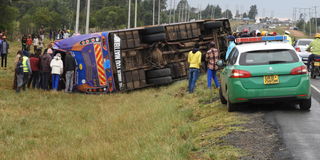Kenha on the spot for failing to erect road signs on key highway in Bomet

A police van at an accident scene near Kapkwen trading centre in Bomet town where a bus belonging to Classic Coach veered off the road and overturned injuring 15 passengers on Sunday July, 31, 2022. The spot is along the Mulot-Bomet-Kaplong highway which Kenya National Highways Authority
The Kenya National Highway Authority (Kenha) is under pressure from residents of the South Rift region to clearly mark and erect signs on the Mulot-Bomet-Kaplong highway so as to curb road accidents.
Kenha has been repeatedly accused of failing to mark the road and allowing residents to put up unauthorized speed bumps in accident hotspots.
Accidents involving matatus, lorries, tractors and motorcycles are common on the key highway that links Nairobi to Western Kenya through Narok.
It also leads to Tanzania via Kisii, and to Kisumu, Kakamega and beyond.
The road is also used by travellers from the Nyanza, Western, Central and North Rift regions to get to the world-famous Maasai Mara National Reserve, a key tourist destination in Narok County that stretches to the Tanzania-Kenya border.
“Unfortunately, the road is not marked and this has led to frequent accidents on the highway causing loss of lives and injuries,” said Ms Hellen Tapleleli, a former nominated member of the Bomet County Assembly (MCA).
Ms Taplelei said Kenha need to help curb road accidents, especially during year-end festivities that start at the end of November.

Construction workers on the expansion of Kaplong-Bomet junction stage in Bomet county
Accident hotspots on the highway include Mulot, Korara, Longisa, Chebole, Tarakwa, Soimet and Kapkwen.
“For years, Kenha has failed to patch up sections of the highway that are worn out, with potholes being a common occurrence,” said Mr Stephen Changmorik, the Longisa ward MCA.
“Even when repairs are made, the work is so shoddy that it hardly lasts three months before the affected sections get washed out by rains.”
Mr Changmorik said Kenha should address the issues raised by residents and motorists.
Compared with other highways, it does not have signs showing sharp corners, children or animals crossing, speed bumps, bridges or speed limits.
Questions have been raised about the quality of construction work on roads funded by Kenha and the Kenya Rural Roads Authority (Kerra) in the region. The roads wear out within hardly three years after construction.
Bodaboda riders are some of the major causes of accidents in the region, with local hospitals full of victims with various degrees of injuries.
Most of the accidents on the highway involve matatus travelling to and from Kisii and Nairobi. They result from over-speeding or drivers being unfamiliar with blackspots on the route.
Tractors driven without lights at night or very early in the morning also contribute to accidents and deaths on the highway.
On July 31, 40 passengers were rushed to Tenwek Hospital with various degree of injuries after a Kisii-bound Classic Coach bus was involved in an accident near Kapkwen.
Eight of the passengers suffered multiple fractures, while others were treated and discharged. The accident occurred when the driver heading from Nairobi swerved to avoid a head-on collision but landed in a ditch.
Several other accidents involving private saloon cars and pickup trucks have been reported on the highway, leading to deaths and injuries.
Traffic police officers stationed at various points on the highway have come under the spotlight for failing to inspect the roadworthiness of vehicles because they are too busy collecting bribes.
The highway is one of the most heavily policed in Kenya, with six roadblocks. Matatu operators part with bribes at all the points, with the money paid to officers ranging from Sh50 to Sh100.

A signage in the outskirts of Bomet town in this photo taken on June, 21, 2022
Despite directives from successive Inspectors-General of police that roadblocks be removed from Kenya’s highways, officers in the South Rift continue to set them up with impunity.
One notorious roadblock set up every night is in the Kyogong area, near Bomet town. When there is a hue and cry from residents, it is moved to Kapkwen. It is not clear where the tens of thousands of shillings collected from the roadblocks ends up.
“It is sad that most of the accidents involve un-roadworthy vehicles. Some without valid insurance are overloaded with passengers, over-speed or have worn-out tires, yet they are allowed to pass through roadblocks,” said Mr Kipruto Ngeno, a human rights activist in Sotik.
Mr Ngeno said relevant government agencies have been repeatedly asked by residents, leaders and motorists to have proper speed bumps and road signs erected on the highway but their pleas have gone unheeded.
“Motorists are advised to be careful on the highway and observe all traffic rules so as to avoid accidents,” said Bomet Central sub-county police commander Musa Imamai.
“Passengers are also encouraged to report any incidents of over-speeding, overloading and other traffic offences committed by public service vehicles or privately owned ones.”
Mr Imamai said passengers were partly to blame for the incidents on the road as they willingly agreed to board overloaded vehicles.
“What passengers do not seem to understand is that if an accident occurs, the insurance cover would not cater for the excess ones in the vehicles,” Mr Imamai said.
Most accidents in the area happen in the morning, late in the evening, at night and during rainy seasons.
But most accidents involving bodaboda riders are not reported to the police because the motorcycles do not have valid insurance and the riders are not trained and thus do not have driving licences. Some riders also do not wear helmets and they carry excess passengers.




